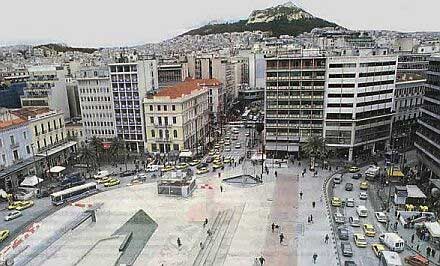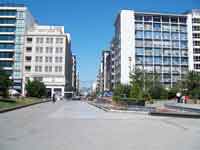.
Omonia Square (Greek: Πλατεία Ομονοίας, Plateía Omonoías, pronounced [plaˈtia omoˈnias], Concord Square, often simply referred to as Omónia, [oˈmonia]) is a central square in Athens. It marks the northern corner of the downtown area defined by the city plans of the 19th century, and is one of the city's principal traffic hubs. It is served by Omonia train station, used by the Athens Metro and the Ilektrikos.

The Square
Omonoia Square early in the morning, 2013.
The circle accesses 3 Septemvriou Street in the north (September 3, exit), Patission Street, Panepistimiou Street (entrance), Agiou Konstantinou Street in the west (formerly entrance/exit, now exit), Panagi Tsaldari Street accessing Pireos Street (formerly entrance/exit, now entrance), Athinas Street (entrance/exit) in the south and now a walkway, while Stadiou Street (named after the ancient Stadium) in the southeast (exit) once continued the circle.
The square's traffic route from the 19th century until 1998 once more fully circumvented the centre with six streets, of which five also functioned as entrances and exits. From the 19th century to the 1950s, the area's layout more literally approached that of a square, framed by broad paths to the edges and centrally, and surrounded by neoclassical buildings. The square's focus also featured a shading arc of palm trees until the 1950s, and a central fountain until 2000, while almost a century ago, ceremonial cannon were once aligned in a central circle. The square including its trees were later and to great criticism demolished, except for the fountain, to make room for the ever-increasing traffic. The area now formed a pentagon facing northwest and greener hexagon to the northeast, with a central circle. Road areas continued to encroach on the previous design in the shape of a circle totaling four lanes, with part of the former road nevertheless transformed into a larger open pedestrian space; but half the neoclassical buildings in the western and northern areas were removed, although some neoclassical structures remain in the northern part and along Athinas Street.
Trees were later replanted within Omonoia Square, and encircled the fountain once again. When part of the square was shut down for renovation ahead of the Athens 2004 Summer Olympics, it was decided to eliminate traffic from the west and east sides, reducing it to the westbound lanes at the southern section and the eastbound lanes at south leaving one route.
Created and Placed in Omonoia Square in 2002, by Greek sculptor George Zongolopoulos, the 'Five - ring' is a stainless steel metal mobile structure used to run with water, 2013.
Celebrations
Sporting celebrations have recently been held here, including following Greece's victory in the Eurobasket 2005 finals and winning the championship. Other sporting successes, such as the Euro 2004 tournament when people climbed on the 'Five - ring' sculpture to celebrate with Greek flags, have also tended to be celebrated here.
Architecture
Omonoia Square, 2013.
After its recent transformation which occurred in 2003 the square has lost some of its former value and prestige, nevertheless it continuous to represent a multicultural place and point of communication as well as transportation hub for thousands of vehicles crossing from there trough out the day. Two of its most recognizable buildings are certainly the old neoclassical hotels: "Bagkeion" and "Megas Alexandros" located side by side, on either side of Athinas street. The Pentakiklon ('Five - ring' sculpture), has its own story. It was placed in the square in 2001 and it hasn't worked properly ever since, except briefly in the Christmas of 2008, when for the first time water run in the sculpture, making the circles moving.
Gallery
Omonoia during the 50's.
Omonoia during the 60's.
References
Coordinates: 37°59′03″N 23°43′40″E
| Ancient Greece
Science, Technology , Medicine , Warfare, , Biographies , Life , Cities/Places/Maps , Arts , Literature , Philosophy ,Olympics, Mythology , History , Images Medieval Greece / Byzantine Empire Science, Technology, Arts, , Warfare , Literature, Biographies, Icons, History Modern Greece Cities, Islands, Regions, Fauna/Flora ,Biographies , History , Warfare, Science/Technology, Literature, Music , Arts , Film/Actors , Sport , Fashion --- |
Retrieved from "http://en.wikipedia.org/"
All text is available under the terms of the GNU Free Documentation License



